July 10, 2020
There is no question that the virus is spreading more rapidly as the U.S. economy continues to re-open. But we believe that the press is overstating the problem. Meanwhile, every economic indicator released in the past two months has been far higher than had been expected. Nevertheless, economists remain convinced that slower growth lies ahead. Despite all this negativism from the press and from economists the stock market marches higher. However, investors worry about the re-imposition of a lockdown similar to what happened in March and April. In our opinion, that is not going to happen for a variety of reasons.
With respect to the virus, we admit that we have no particular expertise. But we do follow numbers and a couple of things seem relatively clear. Every day the press breathlessly reports the number of new cases which now exceed 50,000 per day which is far worse than it was in mid-April when the virus was at its worst. That is a scary-looking chart.
But to a large extent that is happening because many more people are being tested on a daily basis. Today, roughly 650,000 people are being tested daily. That compares to about 150,000 per day in mid-April. If we are testing 500,000 more people today than we were a couple of months ago, of course far more people will test positively! What did you expect? The fact that the press focuses exclusively on the rapidly increasing number of new cases being reported daily is misleading.
The way that the figures should be reported is the percentage of the tests done each day that are positive. As shown below, that figure has been rising. In mid-April about 20% of the test results came back positive, in large part because the only people being tested were ones who were already showing symptoms. As testing has increased, that percentage dipped to about 4.5% by the end of May. It has since climbed to about 8.5%. As the economy re-opens the virus will spread. That should be expected. But is it spreading out of control? We do not think so. While the situation has worsened, it is not nearly as disquieting as the mainstream media would lead us to believe by focusing solely on the number of new positive cases being reported each day. The press chooses sensationalism rather than what we would consider to be a fair assessment of the situation.
The other thing we have noticed is that the press focuses exclusively on those states where the virus is spreading most rapidly – California, Texas, Florida, and Arizona – and ignore the rest of the country. And they love juicy descriptions. Favorite words and phrases are — for the first time, a record number, the most in x days, relentless, ravaging, spiraling out of control. That language is, in our opinion, inflammatory, widespread, biased, and needlessly undermines consumer and business confidence.
Is the situation as bleak as the press would lead us to believe? Absolutely not. With regard to the economic situation, most economists initially expected the recession to last eight months which is about average. Once we learned about the extent of the fiscal stimulus, we thought it might last four months. How long did it last? Two months. Absolutely amazing!
The rebound is evident in every single economic indicator we have received for May and June – payroll employment, retail sales, home sales, the purchasing managers index for both the manufacturing and non-manufacturing sectors. And the July data continue to climb. Initial unemployment claims today, for example, are already 200 thousand below where they were in mid-June.
The number of people receiving unemployment benefits is already 1.3 million less than in mid-June. Each week an additional 1.5 million people file for unemployment benefits, but the number of people receiving unemployment benefits declines by 0.5 million, The only logical conclusion is that the economy was strong enough to produce not only 1.5 million jobs to absorb the new entrants onto the unemployment rolls, but an additional 0.5 million workers to reduce the number of people receiving benefits. That is the description of a rapidly improving labor market.
For what it is worth, we expect an increase in payroll employment for July of 4.0 million workers and we expect the unemployment rate to decline from 11.1% in June to 9.4% in July. While obviously still high relative to the 3.5% level prior to the recession, it is falling far more quickly than anyone expected.
Should we worry about the re-imposition of a lockdown later this year? Absolutely not. First of all, as we explain above, we do not believe the virus is spreading nearly as rapidly as we are being led to believe by the mainstream media. Second, it is not clear that the March/April lockdown did a lot to contain the virus. It may have helped somewhat, but that point is debatable. It seems to us that it probably bought us a bit of time, but as soon as the economy re-opened the virus began to spread — which is exactly what it would have done in the absence of the lockdown. Third, a renewed lockdown at this stage would significantly worsen the economic situation. Many businesses, small ones in particular, have hung on given hope that the economy would rebound. A renewed lockdown would force many to shut their doors for good and result in permanent job losses. Finally, there is an election coming on November 3. Trump wants to get re-elected. If he reimposes a stay-at-home order the economy plunges back into recession. He is not going to allow that to happen.
Our sense is that in the months ahead consumers will find that if they follow the rules – wear a mask, wash their hands frequently, and practice social-distancing – they can safely to go restaurants, grocery stores, retail shops, fly, and go to hotels without undue danger. If that is true, the economy will continue to chug along at a moderate pace in the fourth quarter of this year and beyond.
Try to ignore the negative hype.
Stephen Slifer
NumberNomics
Charleston, S.C.

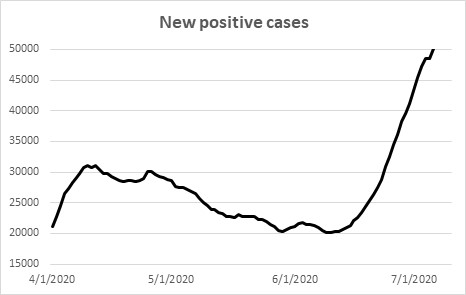
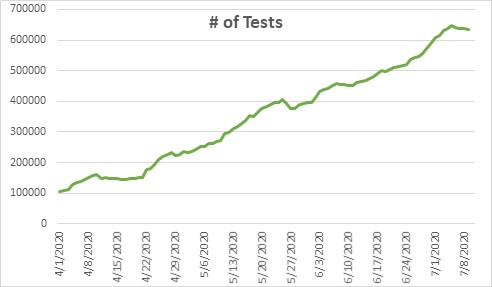
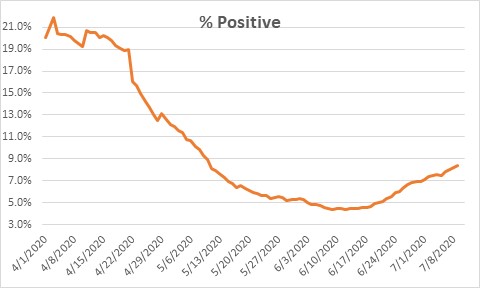
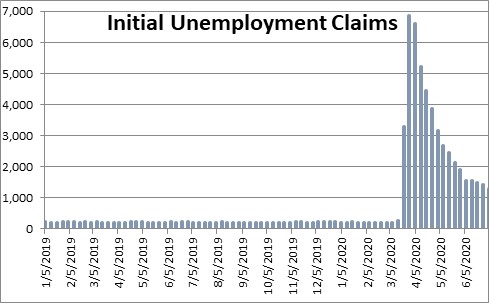
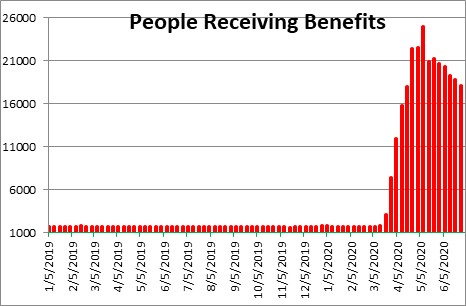

Steve,
You continue to buoy my spirits with your optimism tempered backed up with a lot of good statistical information. Reading this, one would think the media has an agenda. Could that possibly be true?
Thanks as always for your thoughtful insights.
Hi Steve,
I think if the hype was that badly overblown The E.U., Canada and MEXICO would have re-opened their borders to us. “EU officials say the decision was based on a number of scientific factors:
Ensuring that the Covid-19 infection rate in the country was low enough (where nations had fewer than 16 in every 100,000 infected)
That there was a downward trend of cases
That social distancing measures were at “a sufficient level”
None of that did Brazil, Russia or the U.S. meet. I read about the blood clots, long term potential neurological issues etc etc and it’s just something I don’t want to mess with. I’m not a solider, why should I expose myself and my family to a death risk of 1% to 5% (even the White House charts showed a 5% death rate) PLUS the risk of long term complications? If we had a single unified policy, we could bite the bullet and get it over with. Instead we don’t have a policy and so a “safeish” thing like going to an outdoor restaurant is endangered by our 20 something server and the cook who were out partying with friends the night before, who are now handling your food and drink. The other countries that are past this, are past it because of coordinated political and social effort. Unless conditions on the ground change, I can’t see people’s behavior changing.
We need to stop blaming the media. Right now, doctors, other governments, and myself think it’s not safe to resume “normal” activities. Since we don’t have any coordinated science based plan from the White House. I’m going with my research and risk profile in determining my activities. I suspect there’s a fair few number of people, in the middle of the spectrum, who are making the same decision. I saw D.I. Rotary had their last meeting online. Even with masks and social distancing, I just can’t see in person events like Rotary meetings or “normal” public school activities being safe for a while yet. That seems sensible given the facts.
Stay healthy
Best,
Chris
Chris, I do agree with your decision to not to expose yourself or your family to what is, essentially, an unknown risk. Everyone is individually responsible for their own risk management in the absence of clear and complete data. However, I must depart from your reasoning when it comes to our national media. I think, vaccine or not, reported numbers will continue to be “bleak” until Tuesday, November 3rd. Then the pandemic will begin to subside, at least in the press.
Hey Chris,
I think your response this week was probably longer than my article! Apparently I struck a nerve.
I did not say that the virus was not a problem. But is probably not as much of a problem as it is being made out to be. Even if I am right, if I were the E.U. or Canada, or Mexico I probably would probably keep the doors closed to the U.S. for a while longer.
I think the question you raise about why the U.S. experience is do different from China, and Europe is a good one. I don’t know the answer. Nor, I suspect, does anybody else I don’t believe it was because we didn’t tighten down enough. Somehow the combo of what was done at the federal and state levels was sufficient to produce a 50% drop or thereabouts in Q2 GDP. That sounds pretty tight to me. But by the end of beginning of May the business community was teetering on the brink. If we had remained closed for much longer we would not have had much of an economy to re-open. It would largely be gone. Consumers were getting cabin fever as well.
My suspicion (which I could never prove) is that certainly in China, but even in the various European countries, the citizens tend to do what they are asked. But we are so divided there will always be a group that protests. Even now there are folks who think the lockdown was not restrictive enough for long enough. There is another group that thinks we need to get back to business as usual and let the virus run its course.
It sounds like you and your family are behaving responsibly, as are Mary and I, and as is our Rotary Club which has been having virtual meetings since the first week in April. But there is the younger crowd as well asTrump followers who have no intention of wearing masks or social distancing and we are paying the price for their failure to do what they probably should be doing.
In the end, I am not sure the problem is that Trump did not take action soon enough, or that his action was not assertive enough. I think the problem is us. What is that old Pogo saying, “We have met the enemy, and he is us”.
Welcome to America!
All the best.
Steve
Steve
Hi Sidney,
I think the problem with the press began when CNN moved to having news 24/7. They had air time to fill and needed bodies to fill it (of which I was one). If you had half a brain and were willing to go to the studio, you were in. As a result, the quality of what showed up on the news programs deteriorated.
Now we have the internet and anybody can say anything. There is no such thing as fact-checking. And as we all know, there are lots of people out there with an agenda who can easily spread whatever weird idea they support. The bots are programmed to quickly spread the word. Then, we see the video or story appear on the internet, see that it has been read or viewed a million times, and we quickly conclude it must therefore be true. Unfortunately, there are no police on the internet. And nobody seems to bother to ask where the info on the net came from. The infamous “they said” something which is then treated as gospel.
In what I wrote this week I banged on the mainstream media, but the internet is equally bad. I do believe the press is over-dramatizing the virus situation because they want to attract viewers. The media thrives on bad news. And why not? We all love to watch it. When there is some sort of a crisis from the virus, or the latest murder, or riots, or police brutality we are glued to the TV. We have to accept some responsibility for the problem. But who wants to do that? The problem is never us. It is “them” — whoever they are.
Thanks for your thoughts.
Steve
Steve, Sidney,
I agree with much of your points. I do think that we as a nation need to get better. However facts and future shouldn’t be “unknown and unknowable” and blaming media or one party of the other doesn’t really solve any problems.
I’ve spent the last month outside the U.S.. The U.S. is doing a lot of running around in circles and pointing fingers. Something has gone badly wrong with the U.S. and that’s pretty clear to everyone outside of the U.S. Why is it beyond us? This is not the media hysteria. It’s people wanting to resume their lives and being told by a majority of doctors and pandemic specialists that it’s not safe to do so. It’s fine for those of us who can afford to isolate. But we’re in the top 10% or so of the economy. The other 90% aren’t going to be “economically qualified” to protect their families once the payments run out and we haven’t solved the problem. None of us should be very surprised when socialism does come around and we all get taxed to an inch of our lives. We’ve not been able to take care of the majority of people, and they do get a vote in the outcomes. In the short term the stock market should do well, it’s seems to have priced Biden in. I’d stay out of healthcare stocks, Universal healthcare is likely to be strong subject of conversation starting sometime in November.
Best,
Chris
Thanks Neil. Talk soon.
Great article as usual Steve! Here in France, people are good about wearing masks when they go out. We have been out of confinement since June 15 (including kids going back to school) and so far everything has been fine. It is also pretty difficult to get tested here. If you want to get tested, you have to have symptoms and need a prescription from a doctor to get it. Since most people with coronavirus don’t have symptoms, there are surely a lot more cases of it than get reported. Also those swab tests have a high false negative rate, meaning that a significant percentage of people who test negative may actually have it.
Hi Michele. I am glad things are still going well in France one month out of lockdown. As you know, that is not the case here. It is not everywhere. But in half a dozen states (including South Carolina) cases are climbing rapidly.
As I mentioned in the article, I do not think this was bad policy. A measure that causes GDP to fall 50% in Q2 can hardly be characterized as insufficient. And I doubt whether imposing restrictions a couple of weeks earlier would have made a difference.
I think the problem is us. As was said in the comic strip Pogo about 50 years ago (well before your time), “We have met the enemy and he is us.” There are a couple of groups here in the U.S. that choose not to abide by the rules. No masks. No hand-washing. No social distancing. The college crowd and the avid Trump supporters. He doesn’t wear one, why should I? Not sure what to do about that. Just symptomatic of the divisiveness that exists in the U.S. I suppose.
Anyway, stay safe. Drink rose. Enjoy life.
I am a big believer in leadership, and I think our poor results relative to other countries stem directly from the top and our lack of leadership, and lack of interest in addressing the virus. Had Trump insisted on masks, declared war on the virus rather than Americans in Washington DC, Portland, and elsewhere, America would have largely come together as it has done during other wars, there would be far fewer cases and he would win in a landslide.
Hi John,
Thanks for your thoughts. I wish I had a better understanding of why we are having such poor virus results relative to other developed countries. The lockdown didn’t work well. It stopped the meltdown in the stock market and bought us two months, but that is about it. We are probably about where we would have been without it — but with a lot of negative economic consequences if the form of additional government debt as the price that was paid. Perhaps you are right that if in the beginning Trump had just worn a mask and ordered the rest of us to do the same, perhaps we would have had better results. But I cannot help wonder if someone else was president (enter whatever name you want) would the outcome have been different? I am not so sure. As divided as the country is politically, could anybody have pulled us together and gotten us to do nothing more than wear masks? Could anybody have persuaded the spring-breakers to stay home? Not sure . Even the epidemiologists do not seem to be telling a consistent story. We will get through this, but perhaps there was a better way.
All the best.